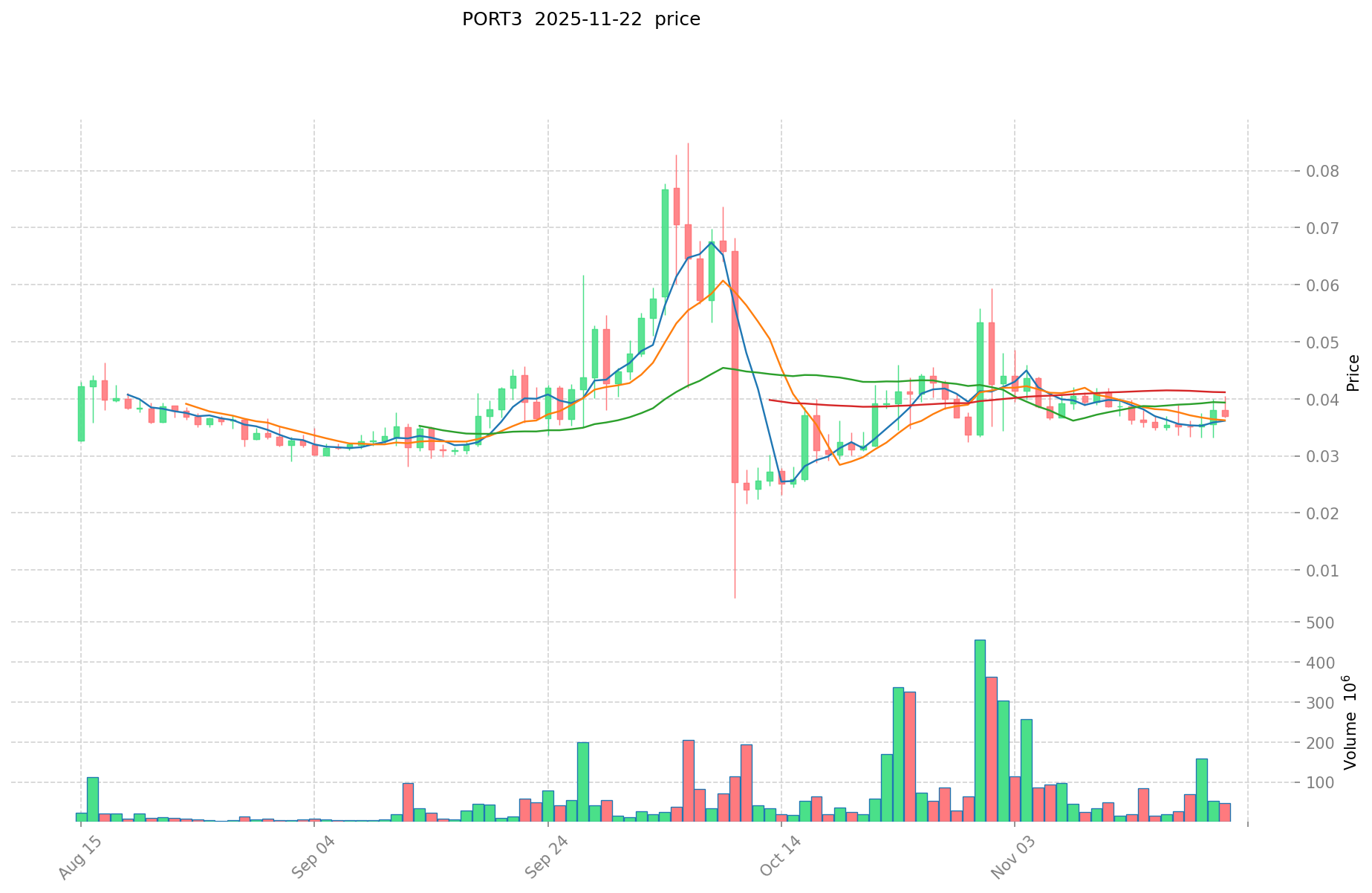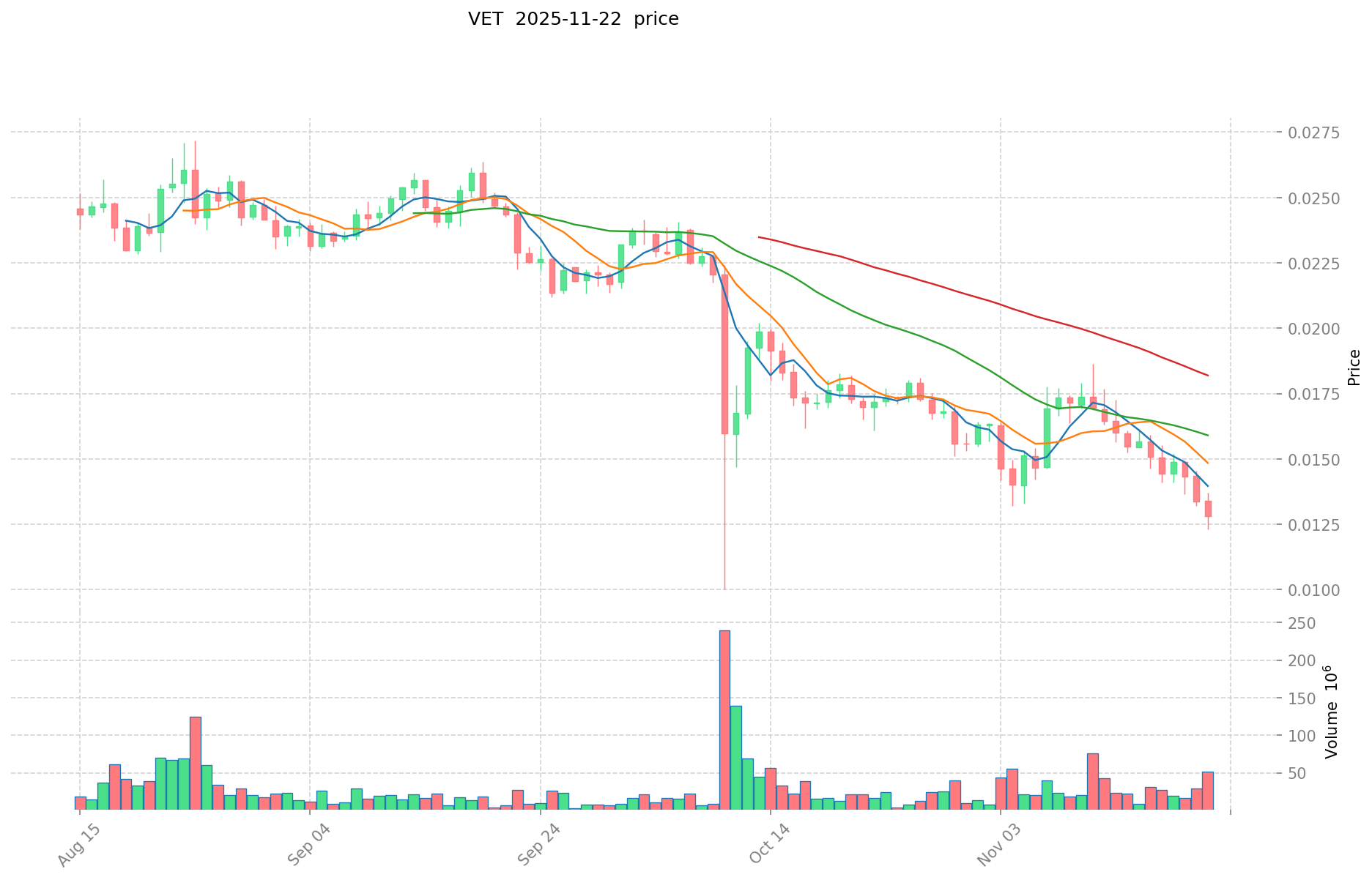PORT3 vs VET: Comparing Two Innovative Blockchain Platforms for Enterprise Solutions
Introduction: PORT3 vs VET Investment Comparison
In the cryptocurrency market, the comparison between PORT3 and VET has always been a topic that investors cannot ignore. The two not only have significant differences in market cap ranking, application scenarios, and price performance, but also represent different cryptocurrency asset positioning.
Port3 Network (PORT3): Launched in 2023, it has gained market recognition for its AI-driven data layer network for Web3.
Vechain (VET): Since its inception in 2017, it has been hailed as a blockchain platform for enterprise solutions, and is one of the cryptocurrencies with significant global trading volume and market capitalization.
This article will comprehensively analyze the investment value comparison between PORT3 and VET, focusing on historical price trends, supply mechanisms, institutional adoption, technological ecosystems, and future predictions, and attempt to answer the question that investors care about most:
"Which is the better buy right now?"
I. Price History Comparison and Current Market Status
PORT3 (Coin A) and VET (Coin B) Historical Price Trends
- 2024: PORT3 reached its all-time high of $0.33 on March 27, 2024.
- 2025: VET experienced a significant decline, with its price dropping by approximately 60% over the past year.
- Comparative analysis: In the current market cycle, PORT3 has fallen from its all-time high of $0.33 to a current price of $0.00984, while VET has also seen a substantial decrease in value over the past year.
Current Market Situation (2025-11-23)
- PORT3 current price: $0.00984
- VET current price: $0.01288
- 24-hour trading volume: PORT3 $5,299,420 vs VET $312,909
- Market Sentiment Index (Fear & Greed Index): 11 (Extreme Fear)
Click to view real-time prices:
- Check PORT3 current price Market Price
- Check VET current price Market Price


II. Core Factors Affecting the Investment Value of PORT3 vs VET
Supply Mechanism Comparison (Tokenomics)
- PORT3: Limited supply of 100 million tokens with a deflationary mechanism through token burning
- VET: Total supply of 86.7 billion tokens with no maximum cap, utilizing a dual-token system with VTHO
- 📌 Historical Pattern: Deflationary models like PORT3's tend to create price pressure over time, while VET's larger supply requires stronger adoption metrics to drive price growth.
Institutional Adoption and Market Applications
- Institutional Holdings: VET has stronger institutional backing with partnerships including Walmart China, BMW, and PwC
- Enterprise Adoption: VET has established use cases in supply chain management and product authentication, while PORT3 focuses on Web3 identity solutions
- Regulatory Attitudes: VET has gained more regulatory clarity in multiple jurisdictions, particularly in Asia, giving it an advantage in enterprise adoption
Technical Development and Ecosystem Building
- PORT3 Technical Upgrades: Development of decentralized identity verification system and cross-chain compatibility features
- VET Technical Development: PoA 2.0 consensus mechanism enhancing security and throughput, VeChainThor platform improvements
- Ecosystem Comparison: VET has a more mature ecosystem with established enterprise solutions, while PORT3 is building around Web3 identity management and cross-chain interoperability
Macroeconomic and Market Cycle Factors
- Performance in Inflationary Environment: VET's utility in real business applications provides some inflation protection, while PORT3's limited supply model could theoretically serve as a hedge
- Macroeconomic Monetary Policy: Both tokens show sensitivity to broader market conditions, with VET demonstrating more resilience during market downturns due to its business integration
- Geopolitical Factors: VET's strong Asian presence, particularly in China, exposes it to regional regulatory risks, while PORT3's focus on decentralized identity may find opportunities in cross-border verification needs
III. 2025-2030 Price Prediction: PORT3 vs VET
Short-term Prediction (2025)
- PORT3: Conservative $0.006183 - $0.00847 | Optimistic $0.00847 - $0.008809
- VET: Conservative $0.011085 - $0.01289 | Optimistic $0.01289 - $0.017530
Mid-term Prediction (2027)
- PORT3 may enter a growth phase, with an estimated price range of $0.010111 - $0.011186
- VET may enter a bullish market, with an estimated price range of $0.010992 - $0.021652
- Key drivers: Institutional capital inflow, ETF, ecosystem development
Long-term Prediction (2030)
- PORT3: Base scenario $0.011521 - $0.013881 | Optimistic scenario $0.013881 - $0.014437
- VET: Base scenario $0.018503 - $0.024346 | Optimistic scenario $0.024346 - $0.026781
Disclaimer: The above predictions are based on historical data and current market trends. Cryptocurrency markets are highly volatile and subject to change. This information should not be considered as financial advice. Always conduct your own research before making investment decisions.
PORT3:
| 年份 | 预测最高价 | 预测平均价格 | 预测最低价 | 涨跌幅 |
|---|---|---|---|---|
| 2025 | 0.0088088 | 0.00847 | 0.0061831 | -1 |
| 2026 | 0.012872706 | 0.0086394 | 0.006825126 | 0 |
| 2027 | 0.01118629512 | 0.010756053 | 0.01011068982 | 24 |
| 2028 | 0.012068291466 | 0.01097117406 | 0.0064729926954 | 27 |
| 2029 | 0.01624282319583 | 0.011519732763 | 0.00645105034728 | 33 |
| 2030 | 0.014436529098591 | 0.013881277979415 | 0.011521460722914 | 61 |
VET:
| 年份 | 预测最高价 | 预测平均价格 | 预测最低价 | 涨跌幅 |
|---|---|---|---|---|
| 2025 | 0.0175304 | 0.01289 | 0.0110854 | 0 |
| 2026 | 0.018100138 | 0.0152102 | 0.008974018 | 18 |
| 2027 | 0.0216517197 | 0.016655169 | 0.01099241154 | 29 |
| 2028 | 0.024516408768 | 0.01915344435 | 0.011875135497 | 48 |
| 2029 | 0.02685695966757 | 0.021834926559 | 0.01724959198161 | 69 |
| 2030 | 0.026780537424613 | 0.024345943113285 | 0.018502916766096 | 89 |
IV. Investment Strategy Comparison: PORT3 vs VET
Long-term vs Short-term Investment Strategies
- PORT3: Suitable for investors focusing on Web3 identity solutions and cross-chain interoperability potential
- VET: Suitable for investors seeking established enterprise adoption and supply chain management applications
Risk Management and Asset Allocation
- Conservative investors: PORT3: 20% vs VET: 80%
- Aggressive investors: PORT3: 40% vs VET: 60%
- Hedging tools: Stablecoin allocation, options, cross-currency portfolios
V. Potential Risk Comparison
Market Risks
- PORT3: Higher volatility due to lower market cap and trading volume
- VET: Exposure to broader cryptocurrency market sentiment and enterprise adoption cycles
Technical Risks
- PORT3: Scalability, network stability
- VET: Mining centralization, security vulnerabilities
Regulatory Risks
- Global regulatory policies may have differing impacts on both tokens, with VET potentially facing more scrutiny due to its enterprise focus
VI. Conclusion: Which Is the Better Buy?
📌 Investment Value Summary:
- PORT3 advantages: Deflationary model, focus on emerging Web3 identity solutions
- VET advantages: Established enterprise partnerships, mature ecosystem, real-world applications
✅ Investment Advice:
- New investors: Consider a conservative allocation favoring VET due to its established market presence
- Experienced investors: Balanced portfolio with both tokens, adjusting based on risk tolerance
- Institutional investors: Evaluate VET for supply chain solutions, explore PORT3 for potential in Web3 identity management
⚠️ Risk Warning: The cryptocurrency market is highly volatile. This article does not constitute investment advice. None
VII. FAQ
Q1: What are the main differences between PORT3 and VET? A: PORT3 is a newer project focused on AI-driven data layer networks for Web3, while VET is an established blockchain platform for enterprise solutions. PORT3 has a limited supply of 100 million tokens with a deflationary mechanism, whereas VET has a larger supply of 86.7 billion tokens. VET has more institutional adoption and real-world applications, particularly in supply chain management.
Q2: Which coin has performed better in terms of price recently? A: As of November 2025, PORT3 is priced at $0.00984, down from its all-time high of $0.33 in March 2024. VET is currently priced at $0.01288, having experienced a significant decline of approximately 60% over the past year. Both coins have seen substantial decreases in value recently.
Q3: What are the key factors affecting the investment value of PORT3 and VET? A: Key factors include supply mechanisms, institutional adoption, market applications, technical development, ecosystem building, and macroeconomic conditions. VET has stronger institutional backing and established use cases, while PORT3 is focusing on emerging Web3 identity solutions and cross-chain compatibility.
Q4: How do the long-term price predictions for PORT3 and VET compare? A: By 2030, PORT3 is predicted to reach a base scenario of $0.011521 - $0.013881, with an optimistic scenario of $0.013881 - $0.014437. VET's base scenario for 2030 is $0.018503 - $0.024346, with an optimistic scenario of $0.024346 - $0.026781. These predictions suggest potentially higher growth for VET in the long term.
Q5: What are the main risks associated with investing in PORT3 and VET? A: PORT3 faces higher volatility due to its lower market cap and trading volume, as well as potential scalability and network stability issues. VET is exposed to broader cryptocurrency market sentiment, enterprise adoption cycles, and potential mining centralization risks. Both tokens may be affected by evolving regulatory policies.
Q6: How should investors approach allocating their portfolio between PORT3 and VET? A: Conservative investors might consider allocating 20% to PORT3 and 80% to VET, while more aggressive investors could opt for a 40% PORT3 and 60% VET split. New investors may want to favor VET due to its established market presence, while experienced investors could maintain a balanced portfolio of both tokens.
Share
Content